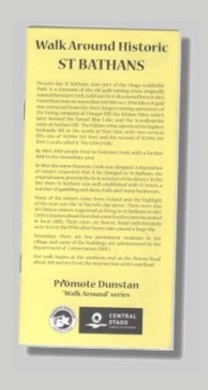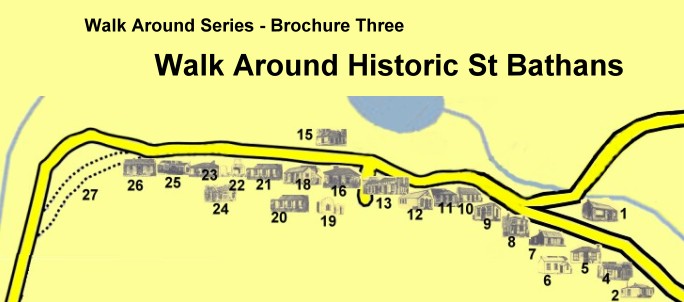| |
ST BATHANS
Present day St Bathans, now part of the Otago Goldfields’ Park, is a remnant of the old gold mining town originally named Dunstan Creek. Gold was first discovered here in 1863. From that time on more than 100 000 ozs ( 2834 kilos) of gold was extracted from the three largest mining operations of the Ewing company at Vinegar Hill, the Kildare mine which later formed the famed Blue Lake and the Scandinavian mine at Surface Hill. The Kildare mine operated the highest hydraulic lift in the world at that time. With two vertical lifts, one of 34.09m (165 feet) and the second of 18.29m (60 feet). Locals called it ‘The Glory Hole’.
By 1864 1,000 people lived in Dunstan Creek with a further 1000 people in the immediate area.
In 1866 the name Dunstan Creek was dropped. A deputation of miners requested that it be changed to St Bathans , the original name given by the first surveyer
(Top)
|
of the district. In the late 1860’s St Bathans was well established with 15 hotels, a number of gambling and dance halls and many businesses.
Many of the miners came from Ireland and the highlight of the year was St Patrick’s day with a picnic. There were also 50 Chinese miners registered as living in St Bathans in 1867. Little is known about them but some lived in caves excavated in local cliffs. Their caves on Downs Road unfortunately were lost in the 1970’s after heavy rain caused a large slip.
Nowadays, there are few permanent residents in the village and some of the buildings are administered by the Department of Conservation (DOC).
Our walk begins at the southern end on the Downs Road about 300 metres from the intersection with Loop Road. |
No 1 Jack Cormack Cottage site
On this site was the home of Jack Cormack, a telegraphist with the telegraph company whose employees also delivered the village mail. Jack was recalled as being a very kindly, portly gentleman whose stomach protruded right over his trousers which were secured by a wide leather belt. He had bowyangs of binder twine tied just below the knee and metal expanding bands to keep his sleeves out of the way.
(Top) |
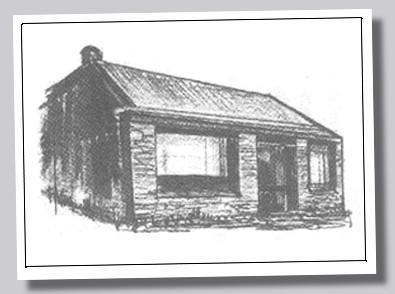 |
| |
 |
No 2 Pat Kenny’s home
Across the road is the site of Pat Kenny’s home. He was a slightly built man who ever had much to say. Kenny was the publican at the Commercial Hotel for 10 years from 1869 to 1879. After this time he became a rabbiter and sometime miner as well as carrying out duties as Clerk of the Course for the annual races.
Next to Kenny lived Joe Gallagher and the Hanrahans.
(Top) |
| |
No 3 Cottage Hospital
Also on the left of the Downs Road was the Cottage Hospital. It was erected mainly by local contributions and was constructed of sun - dried brick with seven rooms, including a ward for three patients, a surgery and a doctor’s residence . At the back was an ‘isolation room’ which also served at times as a post-mortem room. The first doctors were Stenhouse and Brugh. It later became a private residence and then was taken over by the Rabbit Board to house its employees.
On the road behind the cottage were several other residences but nothing remains today.
(Top) |
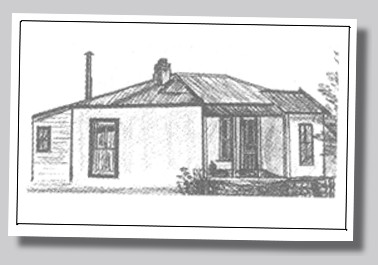 |
| |
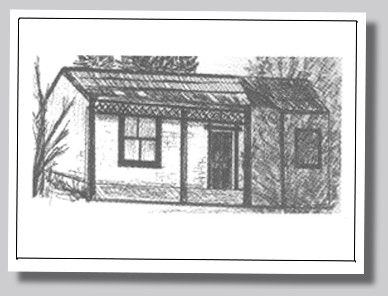 |
No 4 Andrews residence
Next to the hospital on the immediate right was the home of the McConnochie sisters and then Bob and Eliza Andrews, both of whom had their birthdays on 3rd January. They had two children, Theresa and ‘Young’ Bob. On the day young Bob went off to the Second World War the village gathered at the Vulcan to farewell him and another young lad from Becks. While serving in the Middle East Bob sent all the Catholics dried flowers from the Holy Land. He was killed shortly after in Libya. The Andrews are buried in the Catholic cemetery. The house is still owned by the family.
(Top) |
| |
No 5 Don Sutherland’s
In 1900 it was occupied by two penioners, Mr and Mrs Eagle. It became the home of Don Sutherland when he came to St Bathans in the 1930’s for his health. He had TB and St Bathans had a growing reputation for ‘miracle’ cures because of the wonderful air. Don was renowned for his wonderful garden and his quick temper. He used to be the cook for the shearing gangs and often on the drive to the sheds he would get into an argument about politics, jump out of the truck and walk home. Once after a particularly violent disagreement he returned with his shotgun. Not surprisingly everyone agreed with his opinion.
Despite his health he was a heavy smoker. Once when riding his horse ‘Geordie” he accidently flicked his butt into the sack carriers behind the saddle which eventually burst into flame. Needless to say Geordie took off at speed. Geordie was always to retain the scar of the burn with a large bare patch on his rump. There is a photo of them both in the hotel. Don is buried in the St Bathans Public Cemetery.
(Top) |
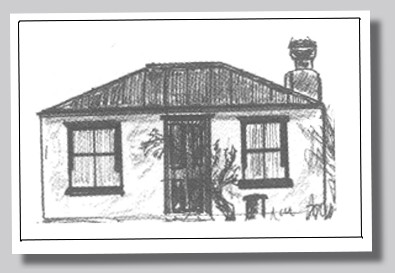 |
| |
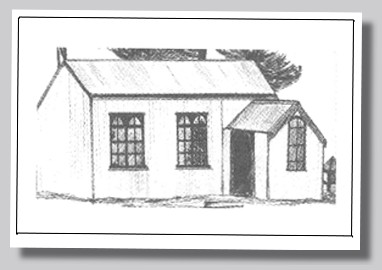 |
No 6 St Alban’s Church
The original church blew down in a severe gale in 1870 and its replacement met a similar fate in 1883. Captain Dalgety of Dalgety Rope and Twine fame, the then owner of Hawkdun Station, bought the and on hearing of the dilemma bought the ¼ acre section on which the church stood. He then shipped out a new church in sections from the United Kingdom making it one of the first prefabricated buildings in NZ. St Alban’s is an Anglican church but is used for interdenominational services on many occasions.
(Top) |
| |
No 7 Patrick’s Cottage
The little dwelling known as ‘Patrick’s’ Cottage belonged to
Patrick Fahey, a strikingly good looking Irishman noted for his wit. After time spent in the gold rush at Gabriels Gully near Lawrence, he moved to St Bathans as the manager of the Muddy Creek Channel Company. Two of Fahey’s daughters-in-law are buried in the Catholic cemetery.
In between this cottage and the Post Office was a reservoir which was filled from the race which crossed the hill.
(Top) |
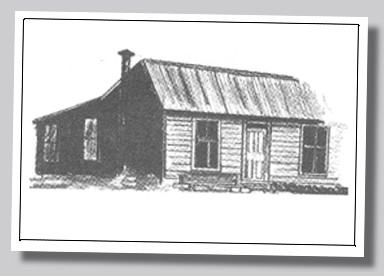 |
| |
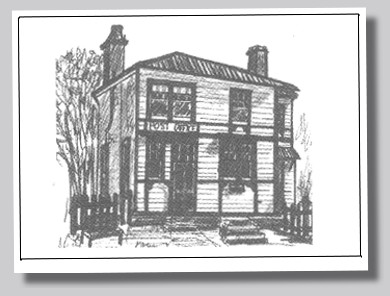 |
No 8 Post Office
The original Post Office was a small ‘dog box’ and opened under the name of Dunstan Creek in July 1864. The first postmaster was John Campbell a storekeeper in the town. The present imposing two storey building, built by J Drummey for £685 /4/- ($13370.80), was opened in 1909.
It became the home of Neil Nicholson, a mine manager and his family. Neil Nicholson is buried in the Catholic cemetery.
The building is now owned by DOC and is again officially operating as a post office. It has regained the use of the original franking stamp for St Bathans.
The vacant sections next door were the sites of houses belonging to the Hanger family and the Wilkinson brothers, Tom and John. Originally ship builders from Newcastle, they constructed many of the buildings in St Bathans, Naseby , Oturehua, and Ophir.
(Top) |
| |
No 9 Bank and Gold Office
This building, one of three former banks in the township was opened in 1864 as the Bank of new South Wales and was originally located across the road near the present tennis courts. At the time is was described at the time as a ‘sturdy wooden building with a staff of two’. It was also known as the Gold Office. The building was moved to Oturehua in the 1970’s and the restored building was brought back to St Bathans by DOC in the 1980’s and placed on this site.
(Top) |
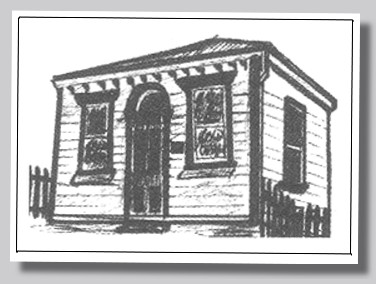 |
| |
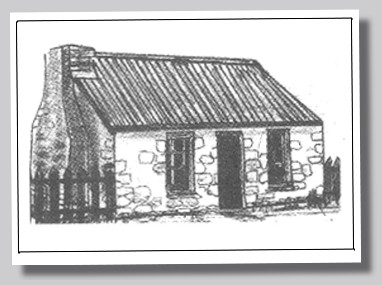 |
No 10 Blacksmiths
Next door was the blacksmith’s forge. It was opened by the Hangar brothers in 1866. In those days a strong hack could be shod for 8/- to 9/- shillings (80 - 90c)and a draught horse for 11/- to 12/-.($1.10-$1.20). In the 1030s a Mr Williams owned the forge, a favourite haunt for children who were fascinated by the blacksmith wearing his black singlet and leather apron, and hammering at the hot iron to shape the horse shoes. He also sharpened picks and other tools. The Williams’ family are buried in the public cemetery.
(Top) |
| |
No 11 Rowan Cottage
At the back of the blacksmiths is Rowan cottage, home to another blacksmith, a Mr Wilson whose forge was by the courthouse. Mrs Wilson was to live in the cottage well into the 1950’s and is buried in the public cemetery.
(Top) |
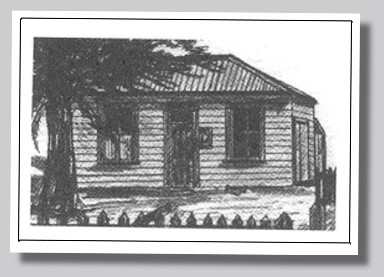 |
| |
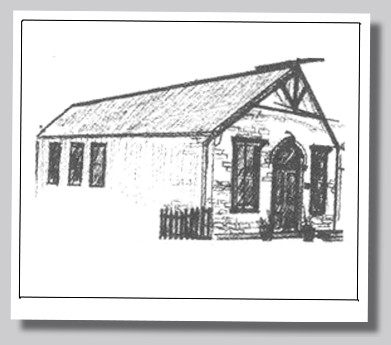 |
No12 The Public Hall
Built in 1880, the front two rooms of the hall were gold office used by the Scandanvian Mine and other mining and water race companies. It was the meeting place for the St Bathans Masonic Lodge No. 126 which held its first ceremony was held on November 11th,1902. The Star of David is still visible in the ceiling.
The backdrop of the hall was painted in 1876 by a travelling German artist and is a wonderful example of the period.
Over the years the hall has been the venue of countless perfomances and entertainment. It is unusual in that it has a sprung floor and there are still memories of dancers being swung round during the ‘Alberts’, the ‘Lancers’ and other similar dances. The hotel next door was required to shut itas doors between each dance so the men would return to the hall. The dances continued until quite recent times after the annual Gymkhana Races. Films were also screened every week. The hall has recently undergone an extensive maintenance programme. Photographs from the early days are displayed inside.
(Top) |
| |
No 13 Vulcan Hotel
The Vulcan Hotel, a well preserved landmark, was originally the Ballarat Hotel, built in 1882. Its name changed after fire destroyed the original Vulcan hotel further down the street. It is built of sun-dried bricks made by Tom Griffiths and John Gallagher who then built the hotel. The original publican was E.Dooley followed by P.Hanrahan and since then there have been many varied and colourful publicans.
The shamrock, which can still be seen on the front facade, is a relic from the times of the rivalry between the Irish settlers from St Bathans and the Welsh settlers from Cambrian just down the road. This rivalry was known locally as “The War of the Roses” and at one time the acrimony between the two villages was quite bitter.
A friendly ghost is said to have taken up residence in Room 1 and there are many people ready to attest to her presence. The little pool room which is attached was added in the 1960’s.
In the 1990’s the hotel was put into a trust with shares owned by locals who lease out the hotel.
In 1967, when 10 o’clock closing was being promoted, the 22 residents of St Bathans residents unanimously voted for the later closing time. It was reported widely throughout the country‘s media as being the only place which had made a unanimous decision.
(Top) |
 |
| |
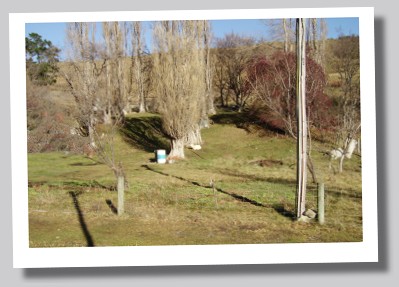 |
No 14
These vacant sections next door were once occupied by a boot maker, the Victorian Hotel, the original Vulcan Hotel, (now occupied by a new stone house) and McConnachie's home and store. The latter opened in 1866. Several photographs of the store in the large snowfall of 1908 are displayed in the hotel. Alongside was another store built in 1865 by William Pyle. The McConnochie and the Pyle family are buried in the public cemetery.
(Top) |
| |
No 15 The Billiard Room
Across the road and now in solitary splendour is the Billiard Saloon completed in 1881. It was part of the hotel complex and in the early days was managed by Mosie Hanrahan who was a heavy drinker. One day after consuming a large amount of liquor he fell into a snow drift and had to be pulled out when he was unable to extricate himself.
Hay used to be stored in the loft and the stables were at the back of the building. There were seven loose boxes and five stalls for travellers to stable their horses.
In earlier times there were a number of buildings on this side of the street but nothing remains of them.
(Top) |
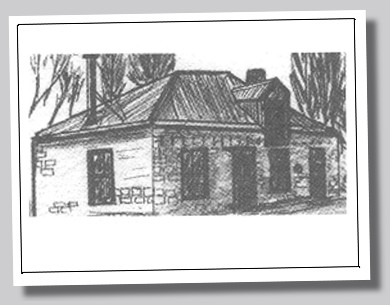 |
| |
 |
No 16 The School House
Back across the road is the stone School House. The first school, a small wooden building, was built hewre in 1866 with an opening roll of 10 boys and 15 girls. It was replaced in 1879 by a school residence built by Grey and Morris at a cost of £349 /5 /- ($799.00).
The first school teacher to occupy the house was Mr Ings. There followed a series of teachers who, for one reason or another. experienced difficulties with either the inspectorate or the school committee.
(Top) |
| |
No 17 Wetherspoon’s /Scherp’s Bakery
Now an empty section, the bakery has long gone but its ovens can still be seen on the hillside.
(Top) |
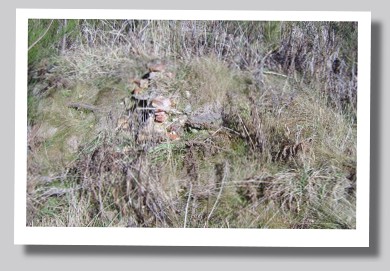 |
| |
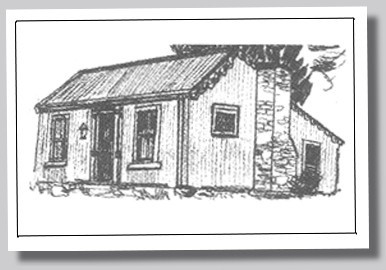 |
No 18 Replica Cottage
Built in the 1990’s this is a replica of the original cottage on this site which was occupied by the Rankin family.
(Top) |
| |
No 19 Old School Ruins
On the left, walking up Cross Street, is the old school ruins. It was built in 1875 and en larged in 1885 to cope with the increasing school roll. The longest serving teacher was Robert Cowan who was appointed in 1888 and stayed until 1916. A martinet, he was renowned for both his discipline and his sense of fairness. He is best remembered for his reaction to an inspector who disciplined one of the pupils. Cowan objected and invited the inspector out into the corridor where a fist fight took place, much to the delight of the listening pupils.
Huge cracks which appeared in the building after a severe earthquake in 1943 forcing the school to close and classes were held in the Post Office building until 1949.
(Top) |
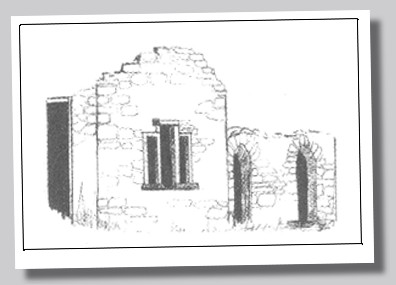 |
| |
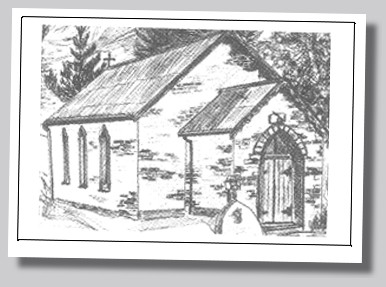 |
No 20 St Patrick’s Church
At the top of Cross Street is the Catholic Church of St Patrick. It was built after the original church in another part of the village was destroyed in a storm. The tender for the present building was won by Michael Kearney for £3 / 17 /6 ($7.75) for the 3000 bricks which were transported to the site. The building was opened in 1892 and consecrated by Bishop Moran. It is one of the few churches left with a surrounding graveyard and many of St Bathans early settlers are buried here.
Immediately below the church on the left was the Toomey dwelling. Toomey had horses and worked as a contractor in the early 1900’s.
(Top) |
| |
No 21 Police Camp and Jail
Further down the hill is the site known as the Police Camp. The camp was first occupied on the 29th October 1864 shortly after the calico town became established, with one second class mounted constable and one foot constable. By 1866 this had been reduced to a constable and a horse!!! Early constables included Cameron, Murdoch , Davis, Kennedy and Hood. By the 1930’s this position was held by Danny Sugrue, known to the local children as Danny Sugaroo. The jail alongside the police house was used in the 1930’s as a playhouse by the constable’s children but was removed with much secrecy during the Second World War under the Official Secret’s Act. It was returned to its present site in the late 1990’s.
The jail, along with the police house, is now available for overnight stays.
A number of empty sections on the northern side of the police house once housed occupied by the Wheelers, “Bowleg” Sherp from the bakery, Mosie Hanrahan, and the Wilkinson family.
(Top) |
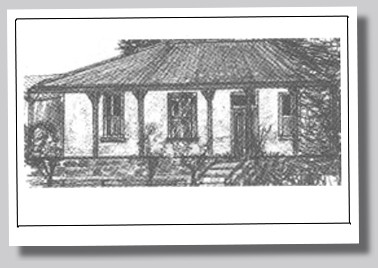 |
| |
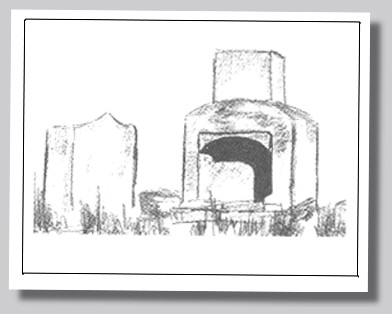 |
No 22 Courthouse Ruins
Futher down the street is a section with a lonely looking fire place and surround. This is all that remains of the once imposing Courthouse building and the warden’s residence which were erected in 1895. The courthouse was removed to Clyde in September 1943 where it is now a private residence. Across the road is a steel etching of the building but the weather has made this difficult to decipher.
The empty section next door was occupied by several small dwellings lived in by the Eagle and Regan families whose graves can be found in the public cemetery.
(Top) |
| |
No 23 The Mine Managers Residence
This was built for the manager of the Kildare Mine (which is now the Blue Lake). In 1876 mine managers received £4 ($8.00) and miners £3 ($6.00) per week.
Walter Johnstone was the manager of the Kildare Mine in the 1930’s when the hydraulic lifts were the highest in the world.
In 1934 the mine was served with a notice to stop all work because there were fears the diggings would undermine the township. The deepest workings are now submerged under the Blue Lake.
(Top) |
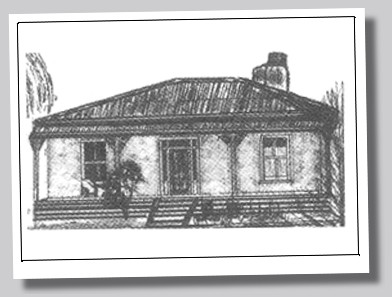 |
| |
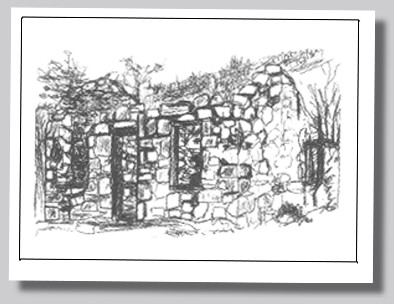 |
No 24 Ruins
Behind the mine managers house on the hill are the remains of what was a large residence. This was occupied by the O’Hallorans and later by the Meek family.
(Top) |
| |
No 25 Excell Builders /Scherp’s Cottage
On the right of the mine manager’s residence is the small wooden cottage where the elderly Mrs Scherp lived in the 1930’s. Her son was the township’s baker (mentioned earlier).
The original building was a five room dwelling built by the Excell builders but this was reduced to one room when Mrs Scherp moved in. The other buildings were shifted to a local farm to become a woolshed.
The Scherp’s graves can be found in the public cemetery.
(Top) |
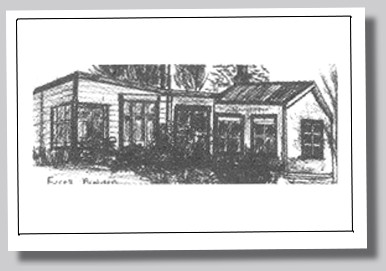 |
| |
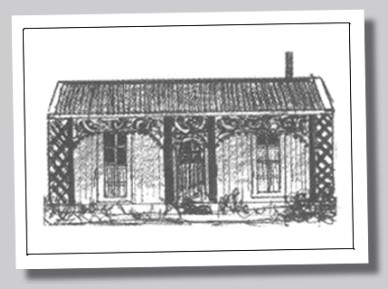 |
No 26 Replica Miners Cottage
Several mining families lived on the next few sections, including the section where the replica miner’s cottage is built. Families from the early 1900’s included the O’Dowd‘s, the McNamara’s and the Webbs. Up above, on the ‘top’ road, were three miners cottages belonging to ‘Shuffle’ Gray (named for his shuffling gait as well as his expertise in cards), the Eagle and the Harrix families. The Gray and the Eagle family are buried in the public cemetery.
(Top) |
| |
No 27 All Nations’ Point
Towards the bend in the road are more vacant sections once occupied by miners and their families. The gravel road follows the original track over the small rise. This section of the town was known as All Nations' Point because at one stage, so the local legend goes, more than 26 nations were represented by the residents.
On the hill to the left of the rise are the remains of an early orchard belonging to Semple’s, which still produces edible fruit.
(Top) |
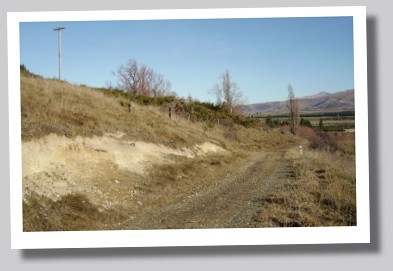 |
| |
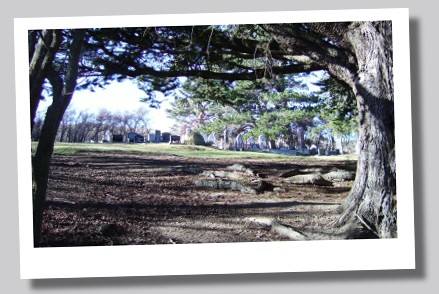 |
The Cemetery
This is the end of our walkway but we recommended to carry on further to view the public cemetery. This is where the non-Catholics were buried. A wealth of local history can be gleaned from reading the inscriptions on the graves.
At the start of the road to the cemetary on the right lies the the Recreational Ground (‘The Rec’) where camp sites are available. It is also where local festivities such as the annual Boxing Day races and Gymkhana and St Patrick’s Day picnics were held and where the annual ‘Wooden Cup' rugby and hockey games still take place. In earlier days it was used for the annual games between Cambrian and St Bathans. It was said this was the furthest that the Welsh of Cambrian would come into St Bathans during the ‘War of the Roses’.
(Top) |
| |
The profile map includes information copied from Kennedy’s archive and depicts occupants in 1908 on the opposite side of the road to the walkway beginning at the intersection of Loop Road and the Downs Road.
Some of these buildings and occupants lingered in to the the 1930’s but most dwellings disappeared after the Second World War. |
The sun-dried brick buildings, like other dwellings in St Bathans, quickly succumbed to the weather after their roofs were removed for their iron.
Many families who lived in the surrounding area are not mentioned. A surprising number of descendants of these early settlers still live there.
|
| |
Acknowledgements
Anne Wright (Artist)
Mary Blyth
Joan Cavanagh St Bathans Area Association
(Top) |
Reference
Gladys Nicolson - Garret. 1977. St Bathans. John McIndoe, Dunedin
DOC Chronicle of Papers
Mason, Judy and Wilson, Heather . 1988. The History of Education in the Upper Manuherikia Valley. Central Otago News Print. Alexandra.
R.V.Kennedy .’Recollections of 1908’. Special archives. Hocken library, Dunedin. |

